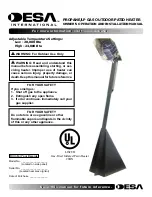
50
ARTC-SVX005B-EN
Trane can provide concentrated solutions of Dowfrost,
propylene glycol, or premixed solutions for use with
the chiller.
N
NO
OT
TIIC
CE
E
E
Eq
qu
uiip
pm
me
en
ntt D
Da
am
ma
ag
ge
e!!
F
Fa
aiillu
urre
e tto
o ffo
ollllo
ow
w iin
nssttrru
uccttiio
on
nss b
be
ello
ow
w cco
ou
ulld
d rre
essu
ulltt iin
n
p
pe
errm
ma
an
ne
en
ntt d
da
am
ma
ag
ge
e tto
o p
pu
um
mp
p a
an
nd
d iin
ntte
errn
na
all cco
oo
olliin
ng
g
ssu
urrffa
acce
ess..
D
Do
o n
no
ott u
usse
e a
au
utto
om
mo
ottiiv
ve
e a
an
nttiiffrre
ee
ezze
e..
Propylene Glycol
IIm
mp
po
orrtta
an
ntt:: The fluid volume increases as this slush
forms and the temperature cools, flowing
into available expansion volume in the
chiller/heater. If the concentration of glycol
is sufficient, no damage to the chiller/
heater from fluid expansion should occur
within the temperature range indicated in
. When liquids are cooled
they eventually either crystallize like ice or
become increasingly viscous until they fail
to flow and set up like glass. The first type
of behavior represents true freezing. The
second is known as super-cooling. Glycols
do not have sharp freezing points. Under
normal conditions, propylene glycol sets to
a glass-like solid, rather than freezing. The
addition of glycol to water yields a solution
with a freezing point below that of water.
This has led to the extensive use of glycol-
water solutions as cooling media at
temperatures appreciably below the
freezing point of water. Instead of having
sharp freezing points, glycol-water
solutions become slushy during freezing.
As the temperature falls, the slush
becomes more and more viscous and
finally fails to flow.
The calculations in this table are most accurate for
Dowfrost (propylene glycol) and Dowtherm (ethylene
glycol) branded products. Consult your local supplier
or engineering contractor for more precise
recommendations.
The precise concentration of glycol for a particular
chiller/heater is affected by several key factors such as
ambient temperature extremes, entering and leaving
water temperatures, and chiller/heater size. A chiller’s
optimum glycol concentration is modified by these
considerations as reflected in
. These
capacity correction factors are the “best informed
estimates” for chillers with copper evaporators. The
percentages may vary depending on the materials and
alloys of the heat exchangers, total surface area, the
amount of present or future fouling, and the brand of
glycol used.
Table 12.
Freeze and burst protection chart
Water/Glycol
Temperature
Freeze
Protection
Burst Protection
20 °F (-7 °C)
18% glycol mixture
12% glycol mixture
10 °F (-12 °C)
29% glycol mixture
20% glycol mixture
0 °F (-17.8 °C)
36% glycol mixture
24% glycol mixture
-10 °F (-23 °C)
42% glycol mixture
28% glycol mixture
-20 °F (-29 °C)
46% glycol mixture
30% glycol mixture
Storage Provisions
The chiller controls are designed for storage in ambient
temperatures from -20 °F (-29 °C) to 145 °F (63 °C) with
relative humidity from 0% to 100%. The glycol should
be removed from the chiller if the unit is to be stored
for extended periods. Although fluids can be drained
via the plug in the bottom of the evaporator, the
inhibitors in an approved glycol solution will best
protect the surfaces of the evaporator against oxidation
if the glycol remains inside the chiller during storage.
Figure 27.
Water/Glycol concentration freezing
points (in degrees fahrenheit)
















































